Florence County, Wisconsin
Florence County is a county located in the U.S. state of Wisconsin. As of the 2010 census, the population was 4,423,[1] making it the second-least populous county in Wisconsin after Menominee County. Its county seat is Florence.[2]
Florence County | |
|---|---|
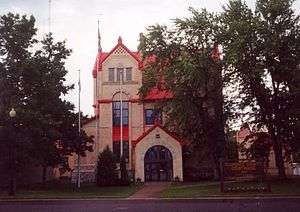 | |
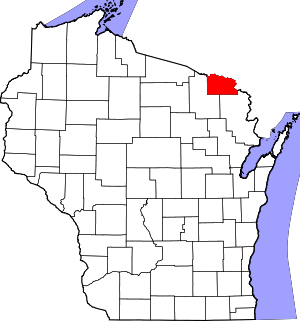 Location within the U.S. state of Wisconsin | |
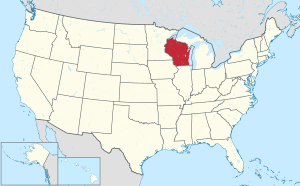 Wisconsin's location within the U.S. | |
| Coordinates: 45°51′N 88°24′W | |
| Country | |
| State | |
| Founded | 1882 |
| Named for | Florence County, South Carolina |
| Seat | Florence |
| Largest town | Florence |
| Area | |
| • Total | 498 sq mi (1,290 km2) |
| • Land | 488 sq mi (1,260 km2) |
| • Water | 9.3 sq mi (24 km2) 1.9% |
| Population (2010) | |
| • Total | 4,423 |
| • Estimate (2019) | 4,295 |
| • Density | 8.9/sq mi (3.4/km2) |
| Time zone | UTC−6 (Central) |
| • Summer (DST) | UTC−5 (CDT) |
| Congressional district | 7th |
| Website | www |
Florence County is part of the Iron Mountain, MI–WI Micropolitan Statistical Area.
History
Florence County was founded in 1882. Florence County takes its name from the Florence Mining Company.[3]
Geography
According to the U.S. Census Bureau, the county has a total area of 498 square miles (1,290 km2), of which 488 square miles (1,260 km2) is land and 9.3 square miles (24 km2) (1.9%) is water.[4]
Adjacent counties
- Iron County, Michigan - north
- Dickinson County, Michigan - east
- Marinette County, Wisconsin - southeast
- Forest County, Wisconsin - southwest
Major highways

.svg.png)



National protected area
- Nicolet National Forest (part)
Demographics
| Historical population | |||
|---|---|---|---|
| Census | Pop. | %± | |
| 1890 | 2,604 | — | |
| 1900 | 3,197 | 22.8% | |
| 1910 | 3,381 | 5.8% | |
| 1920 | 3,602 | 6.5% | |
| 1930 | 3,768 | 4.6% | |
| 1940 | 4,177 | 10.9% | |
| 1950 | 3,756 | −10.1% | |
| 1960 | 3,437 | −8.5% | |
| 1970 | 3,298 | −4.0% | |
| 1980 | 4,172 | 26.5% | |
| 1990 | 4,590 | 10.0% | |
| 2000 | 5,088 | 10.8% | |
| 2010 | 4,423 | −13.1% | |
| Est. 2019 | 4,295 | [5] | −2.9% |
| U.S. Decennial Census[6] 1790–1960[7] 1900–1990[8] 1990–2000[9] 2010–2019[1] | |||
At the 2000 census there were 5,088 people, 2,133 households, and 1,441 families in the county. The population density was 10 people per square mile (4/km²). There were 4,239 housing units at an average density of 9 per square mile (3/km²). The racial makeup of the county was 98.17% White, 0.16% Black or African American, 0.43% Native American, 0.28% Asian, 0.02% Pacific Islander, 0.14% from other races, and 0.81% from two or more races. 0.45% of the population were Hispanic or Latino of any race. 25.6% were of German, 11.6% Swedish, 8.4% Polish, 8.2% Italian, 6.6% French, 5.9% English, 5.4% French Canadian and 5.2% Irish ancestry.[10] Of the 2,133 households 27.50% had children under the age of 18 living with them, 58.60% were married couples living together, 6.00% had a female householder with no husband present, and 32.40% were non-families. 27.90% of households were one person and 12.50% were one person aged 65 or older. The average household size was 2.35 and the average family size was 2.87.
The age distribution was 22.90% under the age of 18, 5.30% from 18 to 24, 27.10% from 25 to 44, 27.30% from 45 to 64, and 17.50% 65 or older. The median age was 42 years. For every 100 females, there were 104.30 males. For every 100 females age 18 and over, there were 101.50 males.
In 2017, there were 31 births, giving a general fertility rate of 57.9 births per 1000 women aged 15–44, the 21st lowest rate out of all 72 Wisconsin counties. 10 of the births were to unmarried mothers, 21 were to married mothers.[11] Additionally, there were fewer than five reported induced abortions performed on women of Florence County residence in 2017.[12]
Communities
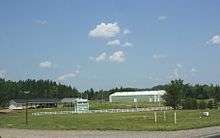
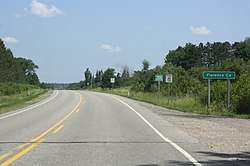
Florence County is one of only two counties in Wisconsin with no incorporated communities, the other being Menominee County.
Census-designated places
- Florence (county seat)
- Long Lake
Unincorporated communities
Politics
| Year | Republican | Democratic | Third parties |
|---|---|---|---|
| 2016 | 71.5% 1,898 | 25.0% 665 | 3.5% 93 |
| 2012 | 62.7% 1,645 | 36.3% 953 | 1.0% 27 |
| 2008 | 56.3% 1,512 | 42.2% 1,134 | 1.5% 39 |
| 2004 | 62.5% 1,703 | 36.5% 993 | 1.0% 28 |
| 2000 | 63.5% 1,528 | 33.9% 816 | 2.5% 61 |
| 1996 | 43.3% 927 | 40.6% 869 | 16.2% 346 |
| 1992 | 35.6% 942 | 37.0% 978 | 27.4% 726 |
| 1988 | 51.6% 1,106 | 47.5% 1,018 | 0.8% 18 |
| 1984 | 58.0% 1,227 | 41.1% 870 | 0.9% 18 |
| 1980 | 52.5% 1,187 | 41.7% 943 | 5.8% 130 |
| 1976 | 48.0% 922 | 50.2% 965 | 1.8% 34 |
| 1972 | 54.1% 971 | 42.2% 757 | 3.8% 68 |
| 1968 | 48.3% 821 | 42.3% 718 | 9.4% 160 |
| 1964 | 36.6% 596 | 63.3% 1,029 | 0.1% 2 |
| 1960 | 51.8% 928 | 47.9% 858 | 0.3% 5 |
| 1956 | 57.9% 1,003 | 41.8% 723 | 0.3% 5 |
| 1952 | 58.4% 1,147 | 41.2% 809 | 0.4% 7 |
| 1948 | 43.0% 756 | 50.3% 885 | 6.7% 117 |
| 1944 | 45.6% 765 | 53.5% 897 | 1.0% 16 |
| 1940 | 50.1% 1,008 | 48.7% 980 | 1.1% 23 |
| 1936 | 41.4% 800 | 53.7% 1,037 | 4.9% 95 |
| 1932 | 40.9% 714 | 55.3% 965 | 3.7% 65 |
| 1928 | 64.3% 993 | 35.0% 540 | 0.8% 12 |
| 1924 | 50.2% 594 | 4.1% 49 | 45.7% 540 |
| 1920 | 86.9% 912 | 9.3% 97 | 3.8% 40 |
| 1916 | 69.4% 412 | 27.3% 162 | 3.4% 20 |
| 1912 | 43.7% 262 | 21.8% 131 | 34.5% 207 |
| 1908 | 81.1% 541 | 15.3% 102 | 3.6% 24 |
| 1904 | 85.4% 562 | 12.6% 83 | 2.0% 13 |
| 1900 | 79.6% 514 | 17.0% 110 | 3.4% 22 |
| 1896 | 78.1% 488 | 20.6% 129 | 1.3% 8 |
| 1892 | 67.9% 449 | 29.5% 195 | 2.6% 17 |
References
- "State & County QuickFacts". United States Census Bureau. Archived from the original on June 6, 2011. Retrieved January 18, 2014.
- "Find a County". National Association of Counties. Archived from the original on May 31, 2011. Retrieved June 7, 2011.
- Gannett, Henry (1905). The Origin of Certain Place Names in the United States. Govt. Print. Off. pp. 127.
- "2010 Census Gazetteer Files". United States Census Bureau. August 22, 2012. Retrieved August 4, 2015.
- "Population and Housing Unit Estimates". Retrieved March 26, 2020.
- "U.S. Decennial Census". United States Census Bureau. Retrieved August 4, 2015.
- "Historical Census Browser". University of Virginia Library. Retrieved August 4, 2015.
- Forstall, Richard L., ed. (March 27, 1995). "Population of Counties by Decennial Census: 1900 to 1990". United States Census Bureau. Retrieved August 4, 2015.
- "Census 2000 PHC-T-4. Ranking Tables for Counties: 1990 and 2000" (PDF). United States Census Bureau. April 2, 2001. Retrieved August 4, 2015.
- "U.S. Census website". United States Census Bureau. Retrieved May 14, 2011.
- Annual Wisconsin Birth and Infant Mortality Report, 2017 P-01161-19 (June 2019): Detailed Tables
- Reported Induced Abortions in Wisconsin, Office of Health Informatics, Division of Public Health, Wisconsin Department of Health Services. Section: Trend Information, 2013-2017, Table 18, pages 17-18
- Leip, David. "Dave Leip's Atlas of U.S. Presidential Elections". uselectionatlas.org. Retrieved April 14, 2018.
External links
- Florence County government website
- Florence County Tourism & Economic Development
- Florence County map from the Wisconsin Department of Transportation

